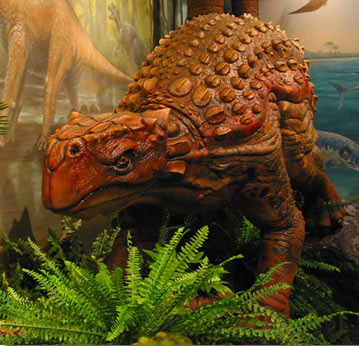
|
Search JoyZine with Google Site Search! |
Minmi
Minmi lived during the early Cretaceous Period, about 119-113 million years ago. It was found near the Minmi Crossing, in the Bungil Formation near Roma, Queensland. Minmi belonged to the Order Ornithischia, Suborder Thyreophora, was an Ankylosaur (a group of tank-like armored dinosaurs that included Euoplocephalus, Talarurus, Saichania, and Talarurus) and a Nodosaurid (ankylosaurs with no clubbed tail that included Hylaeosaurus, Nodosaurus, Panoplosaurus, Sauropelta, and Struthiosaurus). Minmi was unique in two ways. It is the most complete dinosaur yet discovered in Australia, and it has the shortest name of any dinosaur. Minmi was a small member of the family of plant-eating armored dinosaurs. The armour was quite hard and heavy – more like the shell of a turtle than the tough skin of a crocodile – and would have been very difficult to bite through. It had several features not seen before on armored dinosaurs, such as bony armor on its underside, and it may have lacked any kind of spines or spikes on its neck and shoulders. The paravertebrae seem to be ossified tendons rather than bones in their own right, and it may be that such tendons have simply not been preserved in other ankylosaurs. One theory concerning the function of the paravertebrae suggests that they helped to reinforce the back and bear the weight of the armour to allow the creature to run. Given the small size (around 3m long) of the specimen, and the relatively long legs for an ankylosaur, this theory would make sense. Most ankylosaurs would have been too large and heavily armoured to have been able to run at any great speed. The structure of the paravertebrae in Minmi is similar to the tendons seen in the vertebrae of crocodilians, which serve to stiffen the croc's back so they can "gallop" like a rabbit when they are young. The exact relationship between Minmi and other armored dinosaurs is uncertain, however, as it seems to exhibit characteristics of both ankylosaurs and nodosaurs. Minmi has a long postacetabular region of the illium similar to that of scelidosaurs, whereas in ankylosaurs and stegosaurs it is much shorter. The region of the snout arches higher than the roof of the skull, a feature seen in nodosaurs. The pattern of the bones that make up the skull are more similar again to scelidosaurs than either ankylosaurs or nodosaurs. The femora of most ankylosaurs are flattened fore and aft, whereas the femur of Minmi is rounded in cross section, more like those of the ancestral thyreophorans. Minmi may turn out to be closer to ankylosaurs than to nodosaurs, although if so it seems to have split off from them early in their evolution. Similar Minmi-like material from New Zealand suggests that Minmi itself probably did not have a tail club, which is a feature common to almost all other ankylosaurs. Its body shape didn’t allow it to graze on anything that grew too tall. It lived on the floodplains of rivers where there would have been enough low-growing lush vegetation for it to feed on. Recent studies have also uncovered stomach contents associated with this dinosaur. This amazing discovery led to the first reliable analysis of an herbivore's diet. It also proved that ankylosaurs were herbivorous and that their diet consisted of soft plant materials, such cycads, ferns, horse-tail rushes, etc. The size of the material in its stomach also suggests that it had cheeks that allowed it to chew its food before it swallowed. Minmi was the first ankylosaur discovered in Australia. |
